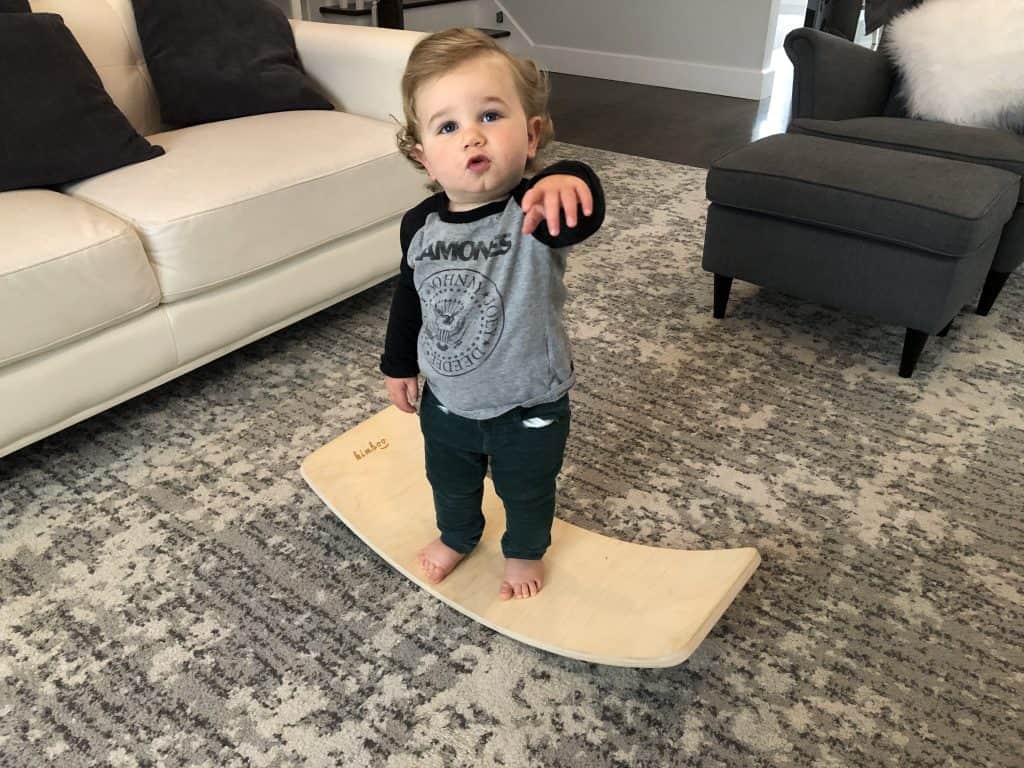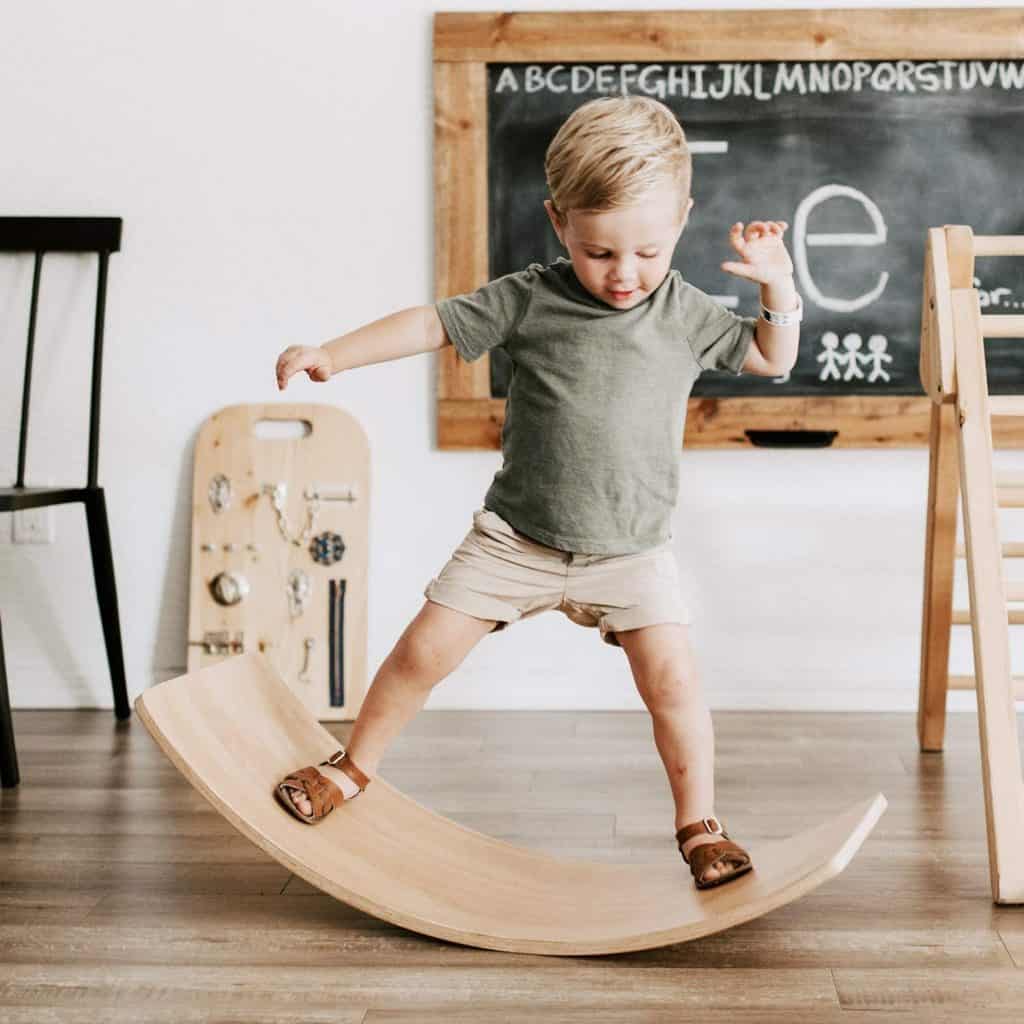Anyone who lives with toddlers knows that they are prone to accidents. Their gross motor and fine motor skills are still developing and this often leads to accidents around the house. At the same time, there are plenty of ways that parents can help their toddlers with the development of their motor skills. One option is called a balance board.
A balance board is a tool that is designed exactly for that purpose: to help people balance. They are commonly used by occupational and physical therapists to help people regain their motor skills and sense of balance following an injury.
Now, they are available for toddlers as well.


If you are looking for a way to help your child with his balance, then take a look at some of the helpful information that we have put together below!
What Is a Toddler Balance Board?
Also called a Montessori board, a wobble board, a rocker board, or a banana board, a balance board is a small, curved tool that is used to help kids encourage both imaginative and active play. A balance board works by helping people, including children, build their muscle strength and coordination by rocking back and forth underneath the feet, helping people build their balance.


The balance board is designed to target not only the muscles in the legs but also the vestibular system. The vestibular system is located in the inner ear and plays a role in balance and movement. In many kids, their vestibular systems are still developing, which is why they might be afraid of certain movements and have trouble balancing.
On the other hand, some kids have strong vestibular systems and cannot seem to get enough of their crazy acrobatics.
In this manner, in addition to helping kids build their motor skills, a balance board can also provide kids with positive vestibular inputs that help them build their balance. At the same time, all of this takes place in the secure environment of their home.


While many balance boards are made out of wood, there are plenty of other balance boards as well. In addition to a wooden balance board, there are also plastic wobble board options. Sometimes, a toddler balance board is designed with a roller underneath. In this situation, the top board of the roller board is flat with a small, cylindrical roller underneath.
What Are the Benefits of a Balance Board?
First, a balance board has been designed for the purpose of helping kids build their gross and fine motor skills. The balance board will build gross motor skills by helping kids exercise the larger muscles in their hips, thighs, knees, and lower legs.
The balance board will also build fine motor skills by helping them use the smaller muscles that play a role in fine-tuning their balance.
A balance board will also encourage creativity, as toddlers usually view the balance board as a toy. In many cases, kids will look at their Montessori balance board and think that it is magical in some way. They might think that it is a bridge to a faraway land, a racetrack or some sort, or even a stage for performances.


In this manner, the balance board also encourages kids to engage in creative play. With their imaginations running wild, the balance board is going to help with not only balance but also creativity as well.
Of course, the balance board is also great for Montessori learning. Using a balance board, kids will take control of their own learning. Because the balance board is usually a simple, wooden tool, your toddler will engage with this all on his own. In this manner, a balance board is great because it provides self-directed learning for your child.
When Can Toddlers Start Using a Balance Board?
Also called a Waldorf toy or a Waldorf rocker board, it is usually suggested that your toddler can start using the rocker board at around 18 months of age; however, keep in mind that child development is a range. Therefore, some kids might be able to start using it at a much younger age.
The pictures you see of my son in this post are from when he was 14 to 15 months of age and he has been walking since he was 10 months old. In general, once children start crawling, cruising, or attempting to walk, they are able to have fun with it.


A kids balance board can be used in multiple ways and even though a child who is just learning how to walk might not be able to balance on it, they can still have fun with it at a young age.
Furthermore, a wooden balance board can still be used well into a kid’s school years. Many kids in elementary school, particularly those who love skateboarding and snowboarding, will continue to use a toddler balance board for years to come. In this manner, it is possible to use a kids wobble board while playing catch, while brushing teeth, and even while taking a dance class or working on yoga. In this manner, your child may never outgrow his kids wobble board.
The Different Types of Balance Boards
If you start looking for a balance board for your child, you are going to find that there are plenty of options from which to choose. Some of the most popular types of balance boards include:

A Wooden Balance Board
Arguably the most popular type of balance board is the wooden balance board. Also called a Montessori balance board or a Montessori board, this is a simple design that does not require any instructions. It is a straightforward, curved piece of wood that will rock from side to side as your child stands on one edge. Without any prompting, most toddlers are able to figure out exactly how this tool works. This is ideal for self-directed learning.

A Plastic Balance Board
Many companies have tried to replicate the wooden balance board by using plastic. While a plastic balance board will still do the trick, they come in a variety of shapes. Some plastic balance boards are a raised, circular design with a small ball underneath that causes it to rock back and forth. Other plastic balance boards are a curved piece of plastic similar to the Montessori board above. Overall, a plastic balance board might be less expensive but it is far less durable than a wooden balance board.

A Roller Board
This is a slightly different design that uses a flat piece of wood or plastic (similar to a snowboard) that sits on top of a roller. The roller shifts the top piece from side to side as toddlers shift their weight from left to right. This is a straightforward design that will work well but might require some instructions.
These are just a few of the many types of balance boards. During the past few years, many parents have uncovered the benefits of balance boards for their children. Therefore, you can tailor the balance board you are going to buy for your child to meet your unique needs. Why not try out a few balance boards and see which one your child likes the best?

Is a Wobble Board Worth It?
This is only a brief overview of the different types and benefits of balance boards. In the end, a balance board is absolutely worth it! Just take a look at that smile!
Of course, it is important for you to do the research and figure out which type of balance board is going to be right for your child.
While it is easy to focus on price, it is also important to think about the size of the balance board and how durable it is.
Remember that you would like your child to be able to use his balance board for years. Therefore, find a balance board that is going to be durable enough to withstand years of wear and tear.
A wobble board, particularly a Montessori balance board, is designed to help your child in multiple ways. In addition to developing his gross motor and fine motor skills, this is also a great toy for self-directed learning because it encourages creativity without requiring much instruction. In this manner, you should consider investing in a balance board for your child. The developmental rewards of a balance board are certainly worth it.
Vikki is the creator of Totsgo and the mother of two children. She is a passionate mother who enjoys assisting other parents.
